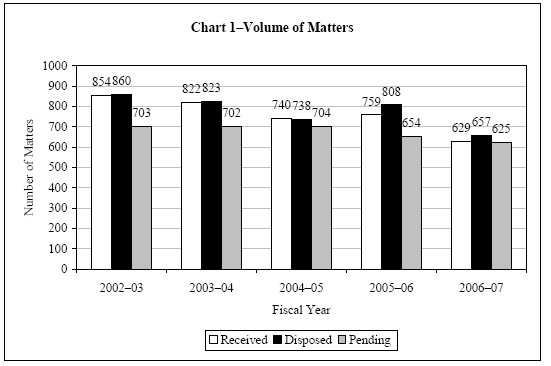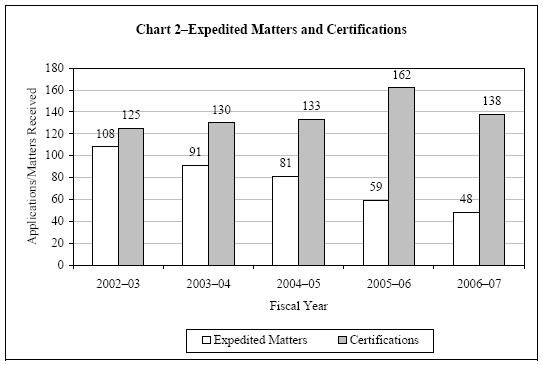Common menu bar links
Breadcrumb Trail
ARCHIVED - Canada Industrial Relations Board
 This page has been archived.
This page has been archived.
Archived Content
Information identified as archived on the Web is for reference, research or recordkeeping purposes. It has not been altered or updated after the date of archiving. Web pages that are archived on the Web are not subject to the Government of Canada Web Standards. As per the Communications Policy of the Government of Canada, you can request alternate formats on the "Contact Us" page.
SECTION I - OVERVIEW
1.1 Message from the Chairperson
 I am pleased to present to Parliament and Canadians the ninth annual Performance Report of the Canada Industrial Relations Board (CIRB or the Board) for the period ending March 31, 2007. This will be the last CIRB performance
report under my chairmanship.
I am pleased to present to Parliament and Canadians the ninth annual Performance Report of the Canada Industrial Relations Board (CIRB or the Board) for the period ending March 31, 2007. This will be the last CIRB performance
report under my chairmanship.
Since my arrival at the Board on January 1, 2004, my operational priorities have been to improve the processing time of applications/complaints, reduce the number of backlog applications that had lingered over the previous years, ensure that Board decisions are sound from an industrial relations as well as legal standpoint, improve relations with stakeholders and ensure compliance of the Board with the ethical expectations of Parliament and Canadians. In terms of the work environment, I also endeavoured and communicated my desire to make the CIRB a workplace where employees could have fun while attaining their performance expectations. I believe that I have met my objectives and that I will leave the CIRB in a better position to manage its workload more efficiently and more effectively in the years to come.
Fiscal year 2006 - 07 has been somewhat unusual for the CIRB. The number of applications/complaints received by the Board fell significantly from the levels experienced in recent years, which is a good thing since it would normally allow the Board to catch up on backlog cases. On the other hand, because of a reduced adjudicative capacity in 2006 - 07, the Board's disposition performance also declined from the levels experienced in recent years. Nevertheless, the number of backlog cases dropped to 625 on March 31, 2007, the lowest level since 1997 - 98. Furthermore, the average processing time of matters disposed of has shown an improvement.
The CIRB has also refined the implementation of a number of initiatives in 2006-07 in order to improve its rate of matter disposition and meet the Board's objective of reducing the level of pending matters and average processing time. These initiatives have had a positive impact on the Board's performance, and more importantly, will continue to have a compound effect in upcoming years. Finally, the Board continues to confer with its Client Consultation Committee, as part of the Board's strategic objective of strengthening linkages and obtaining feedback from its client community.
I am extremely proud and pleased with the accomplishments of the Board and its staff. We are, I believe, well positioned to improve on the fulfillment of our current mandate, with an emphasis on the reduction of both case processing time and the number of pending matters. I would like to take the opportunity to thank the Board's Vice-Chairpersons, Members and its staff for their determination, dedication and support they have provided me over the years.
Warren R. Edmondson
Chairperson
1.2 Management Representation Statement
I submit for tabling in Parliament, the 2006 - 07 Departmental Performance Report for the Canada Industrial Relations Board.
This document has been prepared based on the reporting principles contained in the Guide for the Preparation of Part III of the 2006 - 07 Estimates: Reports on Plans and Priorities and Departmental Performance Reports:
- It adheres to the specific reporting requirements outlined in the Treasury Board Secretariat guidance;
- It is based on the department's approved Strategic Outcome and Program Activity Architecture that were approved by the Treasury Board;
- It presents consistent, comprehensive, balanced and reliable information;
- It provides a basis of accountability for the results achieved with the resources and authorities entrusted to it; and
- It reports finances based on approved numbers from the Estimates and the Public Accounts of Canada.
Warren R. Edmondson
Chairperson
1.3 Program Activity Achitecture
Canada Industrial Relations Board - Program Activity Architecture (PAA)

1.4 Summary Information
Reason for Existence - The mandate of the Canada Industrial Relations Board is to contribute to and promote a harmonious industrial relations climate in the federally regulated sector through the impartial, effective and appropriate administration of the rules of conduct that govern labour and management in their representational and bargaining activities. In achieving this strategic outcome, the Board provides effective industrial relations solutions for the Canadian labour relations community in a fair and timely manner.
Financial Resources (000's)
|
Planned Spending |
Total Authorities |
Actual Spending |
|
$12,366.0 |
$12,665.2 |
$11,658.2 |
Human Resources
|
Planned |
Actual |
Difference |
|
117 |
103 |
-14 |
Change in Management Performance
|
Initiative/Priority |
Assessment |
|
Accelerated reduction of the number of backlog cases |
Successfully met |
|
Reduction of average case disposition time |
Successfully met |
|
Monitoring and fine-tuning of new certification application process and disposition |
Successfully met |
|
Monitoring and fine-tuning of new duty of fair representation complaint process and disposition |
Progress made/Ongoing |
|
Review of reconsideration application process and disposition |
Ongoing |
|
Stakeholder consultations |
Progress made/Ongoing |
1.5 Context and Background
The Canada Industrial Relations Board (CIRB) is an independent, representational, quasi-judicial tribunal responsible for the interpretation and application of the Canada Labour Code (the Code), Part I, Industrial Relations, and certain provisions of Part II, Occupational Health and Safety. It was established in January 1999, to replace the previous Canada Labour Relations Board (CLRB), through amendments to Part I of the Code.
As of March 31, 2007, the adjudicative team of the Board was composed of the Chairperson, four full-time and three part-time Vice-Chairpersons, and four full-time and four part-time Members - all of whom are Governor in Council (GIC) appointees. It may be of interest to note that the Code requires that the Chairperson and Vice-Chairpersons must have experience and expertise in industrial relations, and that Members are to be appointed by the Minister of Labour, after consultation with the organizations representative of employees or employers.
The CIRB has jurisdiction in all provinces and territories with respect to federal works, undertakings or businesses in the following sectors:
- Broadcasting
- Chartered banks
- Postal services
- Airports and air transportation
- Shipping and navigation
- Inter-provincial or international transportation by road, railway, ferry or pipeline
- Telecommunications
- Grain handling and uranium mining and processing
- Most public and private sector activities in the Yukon, Nunavut and the Northwest Territories
- Band Councils and some undertakings of the First Nations on reserves
- Certain Crown corporations (including, among others, Atomic Energy of Canada Limited)
This jurisdiction covers some 1,000,000 employees and their employers, and includes enterprises that have an enormous economic, social, and cultural impact on Canadians from coast to coast. The variety of activities conducted by the federally regulated sector, as well as its geographical spread and national significance, contribute to the uniqueness of the federal jurisdiction and the role of the CIRB, and pose particular challenges for the Board's work.
The Board has established a series of strategic objectives in support of its mandate, which include to:
- conduct all its processes in accordance with the standards of the Code;
- seek solutions to labour relations problems by determining the cause and nature of conflict and by applying the appropriate dispute resolution mechanism, including fact finding, mediation and adjudication;
- conduct its activities in a timely, fair and consistent manner;
- consult its clients on its performance and on the development of policies and practices;
- promote an understanding of its role, processes and jurisprudence through continuous client contact and a variety of information dissemination methods (Web-based and conventional publishing, Board presentations at various forums, 1-800 information request line, etc.);
- conduct its business and manage its resources in a manner that is fiscally sound, in accordance with the Financial Administration Act and the policies and directives of the central agencies of government; and
- ensure continuous interaction with those utilizing Board services through meaningful communication and complaint processes.
1.6 Operating Environment
The last few years have witnessed significant developments and challenges in the sphere of labour relations in Canada and thus for the CIRB. Heightened competition, resulting from the globalization of markets, technological change, the volatility of national and international economies, and corporate mergers have all had an effect on employers, employees, unions and their relationships in Canada.
This is particularly evident in the federally regulated sector where the degree and rate of change has been largely unprecedented, particularly in the telecommunications, air transport (including airports and airport operations), trucking and rail industries. These profound changes associated with a workforce that is largely unionized have led to a situation where the Board is being increasingly called upon to resolve high profile and complex issues between bargaining parties, with substantial economic and social implications for the broader Canadian public.
Typical issues of continuing concern to the Board include:
- the need for assistance to be provided to companies and unions in resolving the labour relations implications of corporate mergers and take-overs - including the determination of bargaining unit structures, representation rights and the merger of collective agreements and seniority rights - notably in the airline and telecommunications industries;
- the acquisition and exercise of free collective bargaining rights, and the promotion of sound labour-management relations in a fair and transparent manner;
- the need to assure that collective bargaining between employers and unions is conducted fairly and in good faith;
- the scope of the duty of fair representation in respect of minority groups of employees;
- the determination of the levels of services required to be maintained during a work stoppage to ensure the protection of the health and safety of the Canadian public, particularly in such enterprises as airports, atomic energy production, and the air navigation system; and
- the prompt consideration of situations in which illegal work stoppages or lockouts are alleged.
The complexity and impact of the issues facing federally regulated employers and unions require the Board to apply a wide range of knowledge and skills judiciously in diverse industrial relations and administrative law contexts. The demand for adjudicative services has thus been historically high, although declining to a more sustainable level over the last two years. Furthermore, the commitment of the Board to promote, wherever possible, the joint resolution of issues by the parties, along with clients' demands for the Board's assistance in mediating unresolved issues as an alternative to litigation, entails increasing demands on the Board's resources. Accordingly, the Board continues to place considerable emphasis on augmenting both its skill and resource levels to meet the needs of its clients.
In the years following the 1999 amendments to the Code that broadened the range of cases that could be heard by the CIRB, the number of applications and complaints filed with the Board rose considerably to 1,154 in 2000-01. Although that number tapered off to 822 in 2003-04, it is still indicative of the wide range of cases brought before the Board. In the five years preceding the Code amendments, the number of incoming matters averaged less than 740 per fiscal year. Over the last three fiscal years, however, the number of applications/complaints has dropped significantly. This is particularly evident in 2006-07, as the number of incoming matters fell to its lowest level since the early 1990s at 629 (see Chart 1).
The reasons for this decline are numerous, and would certainly include the solid jurisprudence that the Board has established since its inception. The Board has always maintained that the larger number of applications/complaints received by the CIRB in the years following the 1999 amendments to the Code were in part due to the lack of jurisprudence on the new Code provisions, since parties were more likely to litigate given the uncertain interpretation of the new Code provisions. Another contributing factor in the recent decline of incoming matters is the state of the economy and of the federally regulated sector. The Canadian economy has been doing quite well in the last few years. The rate of growth has been relatively robust and the level of unemployment has dropped to a level that has not been seen for thirty or more years. At the federal level, the wave of major consolidations and restructuring of the early 2000's, particularly in air transport and telecommunications sectors, has subsided. This has translated to fewer frictions on the industrial relations front, which can be seen by a lower incidence of strikes and lockouts, and also by fewer applications/complaints to the Board.
This appears to be borne out by the CIRB's information. Unfair labour practice (ULP) complaints, which usually represent 40% or more of incoming matters in any given year, and are an indicator of the labour relations climate, are down by 17% in 2006-07. Excluding duty of fair representation (DFR) complaints, which are complaints filed by union members against their union, and which are less sensitive to the state of the economy, the decline in ULP complaints is much more pronounced in 2006-07 at 36%. There were also significantly fewer applications for reviews in 2006-07 (-25%), particularly applications for reconsideration (-39%), and also for certification (-15%), although the decline in applications for certification is largely because there was an above average number of applications in the previous fiscal year.
With respect to the disposition of matters, while the Board has generally augmented its rate of matter disposition in recent years - it disposed of 855 matters per year on average over the five fiscal year periods of 2001-02 to 2005-06 compared to only 756 matters in the previous five fiscal years - its rate of disposition has fallen to 657 in 2006-07 (see Chart 1), the lowest level since 1998-99. This decline in the Board's rate of matter disposition can be attributed to a diminished adjudicative capacity in 2006-07, a situation that also affected the Board in 2004-05. Delays encountered in the appointment or reappointment of Board Members made it somewhat difficult to assign a Board panel to hear cases in many circumstances, and put the onus on single member panels. With the term of one Vice-Chairperson ending on December 31, 2006, the Board was operating with four full-time Vice-Chairpersons instead of five. However, since new cases are seldom given to Members whose term is not renewed or extended, in order for them to close the files they have before leaving, the Board has effectively been operating with four Vice-Chairpersons for most of the year. Unfortunately, this situation is likely to get much worse, as the term of three of the four remaining full-time Vice-Chairpersons, as well as the term of the Chairperson, will be ending in 2007-08.
Another reason for the lower adjudicative output in 2006-07 is that the Board invested in the long term by initiating a policy review of the handling of cases that deal with applications for certification, duty of fair representation complaints and, more recently, applications for reconsideration. The goal of these policy reviews is to reduce the effort and/or time required to process those types of cases. Each of these three reviews is presided over by a Vice-Chairperson. Consequently, this reduces the amount of time he or she has to adjudicate cases per se. Nevertheless, given the decline in incoming matters, the Board felt that this would be an appropriate time to undertake these reviews.
Notwithstanding the lower level of matter disposition, the number of pending matters had fallen to 625 by the end of 2006-07 (see Chart 1), the lowest level since 1997-98.
The Canada Industrial Relations Board Regulations, 2001 (the Regulations) stipulate that certain types of matters require expedited action. These cases include interim order requests, requests to file Board orders in Court, referrals to the Board by the Minister of Labour relating to the maintenance of activities required during a legal work stoppage, applications for a declaration of an invalid strike or lockout vote, applications for a declaration of unlawful strike or lockout, and unfair labour practice complaints respecting the use of replacement workers and dismissals for union activities. Such matters are scheduled, heard and decided in an expedited manner relative to others matters. Priority is also given to the processing and consideration of certification applications, and to any other matter where there appears to be a significant potential for industrial relations problems if there is a delay in its resolution, or where other identifiable factors require a matter to be promptly addressed.
The setting of priorities inevitably results in the deferral of less urgent matters. Scheduling pressures, consequent upon the volume and priority setting, can make very lengthy or complex matters - the kind of matters that are now typically scheduled for oral hearing at the Board - difficult to resolve expeditiously, particularly in view of the reduced adjudicative capacity noted earlier.
The number of matters requiring expedited or priority processing, including applications for certification, has also generally increased since the 1999 amendments to the Code. These matters accounted for almost 30% of all applications/complaints received in 2006-07, although the absolute number was somewhat lower than that observed in the previous four years. Chart 2 sets out the volume of expedited matters and certifications from 2002-03 to 2006-07.


